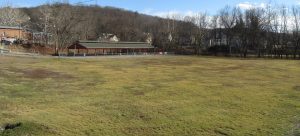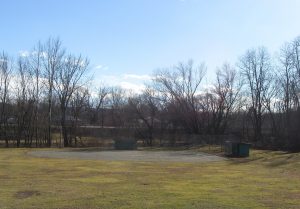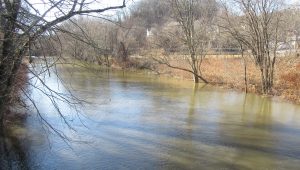The routine threat of flooding from Meshoppen Creek is of great concern to DCNR when it comes to further developing Meshoppen Community Park, but it is typical of obstacles that can be addressed with a Master Site Plan, which DCNR would like to see for the public green space before improvements, such as new playground equipment, can be funded.
Story and Photos by Rick Hiduk
A misunderstanding over the often-complicated process of grant funding for public projects has apparently led to misunderstanding at the borough level in Meshoppen and misgivings on social media. An unofficial meeting was held at the Meshoppen Borough office on Feb. 26 in an attempt to reacquaint interested parties with the process already underway as well as the recommended course of action to pursue needed improvements at the park.
In addition to the borough council and numerous residents, two groups have expressed an interest in recent years to upgrade the park, make it more accessible to the public, and to ensure that there are elements that will be popular with all age groups. Herb Bevan and Dick Salsman are among those who want to bring Little League baseball back to the park. Cindy Cona, founder of Meshoppen Community Day, and a group of volunteer associates want to have new playground equipment installed.
In March 2016, DCNR regional liaison Christine Dettore, Rachel Houser of the Northern Tier Regional Planning and Development Commission, and Wyoming County planner Lynnelle Welch met with borough officials, including Bevan, who is a council member, to discuss the future of the park.
After talking it over and walking around the park, it was decided that a grant from DCNR for a Master Site Development Plan would be the best course of action.
Dettore explained the application process for a DCNR grant that would help cover the cost of a master plan for the park. DCNR is just one funding source among several state entities eager to promote recreation in small communities through responsible construction and improvements. A professionally coordinated master plan is looked favorably upon by DCNR to support further funding.
On April 4, 2016, Meshoppen Borough passed a resolution to secure a DCNR grant of up to $15,000 with the understanding that the borough would match that amount. The cost of the study could come in under $30,000, but that was the “safe” amount recommended by DCNR. Normally, Hauser would have written the application for the grant, but the deadline for receiving the applications was so close that Welch stepped into complete the paperwork needed to obtain the funds.
Welch told those in attendance on Feb. 26 that, from the first time she visited the park next to Meshoppen Creek, she saw incredible potential for the public greenspace to be not only a focal point for recreation but also a viable venue for environmental and educational programs.
“It’s not a lack of support from my office, or I wouldn’t have written the grant,” Welch noted. And, while she understands the desire by so many to install playground equipment sooner than later, she related, “Traditional park equipment will not be conducive to the site due to flooding. It would be a maintenance nightmare. That’s why Christine, Rachel and I suggested the master plan.”
DCNR, Welch added, does not fund maintenance and scrutinizes every application to ensure that maintenance issues have been properly addressed. Modern playground equipment is composed largely of fiberglass for safety reasons. The material becomes buoyant when immersed in flood waters and will pop out of the ground, regardless of concrete footing. Its location in the park is crucial as well, Welch explained, because it should not be in a position to trap debris.
Applying for playground equipment is a great idea, Welch maintained, but installing it prior to the approval of the master plan that the borough is contractually obligated to complete is premature and could negate DNCR’s interest in the project. In the meantime, she urges all parties to be patient.
“This process – because the site is relatively small – will happen quickly,” said Welch. “You can probably apply for another DCNR grant next year.” Without the master plan, however, any additional applications will be scored significantly lower by the review panel.
“(A master plan) may seem like a wasted step,” Welch conceded. “But these grants are highly competitive.”
Bevan and Salsman noted that they have received material donations and had equipment loaned to them to do more work on the ballfield. They would like to apply to Little League headquarters to officially re-certify the community. Other than replacing a dugout and installing the keystone from the former creek bridge as a small monument, however, Welch cautioned them as well from moving too quickly with their plans. Cona was unable to attend the meeting.
Welch had recommended that the $5,000 for which the borough council intended to apply for a Marcellus Legacy Fund grant be applied instead to the $15,000 that the borough has already committed to the master plan, reducing its previous burden to $10,000 or less. If the total cost of the plan comes in under $30,000, DCNR and the borough will split the savings.
At no time, Welch insisted, did she suggest that the money that Cona and her party had raised toward the purchase and installation of playground equipment also be applied toward the borough/DCNR match, as had been implied via social media.
“Well, that’s the way that it was presented,” borough secretary Phyllis Adams said of the last council meeting, when the board publicly rebuked the master plan and moved forward with an application and plans for purchase and installation of new park equipment as soon as possible.
Cona should continue fundraising, Welch recommended. With the completion of the master plan, guidance will be provided on not only where new elements should be installed but what types of equipment work best for different age groups.
Those present were in full agreement that the existing pavilion that was constructed after the 1972 flood is solidly built, structurally sound, and that there are no plans to remove it as had been rumored on social media.
When asked how they should proceed to get the master plan completed as quickly as possible, Adams, Bevan, Salsman, and borough council member Mike Lloyd were told that the borough should review and complete an RFP and scope of work that guides the use and future plans for the park. The RFP is then put out for bids for the services of a non-construction, professional consultant, typically a landscape architect.
Welch suggested that the borough might already have a consultant with whom council members feel comfortable, or she could recommend one and help guide them through the selection process. The right choice now, she noted, could result in a consultant who can also oversee the construction phase of the project.
A series of at least eight meetings will be required over the course of the year. Welch related that this usually begins with an advertised public meeting, followed by six meetings of a steering committee made up of citizens and business and civic leaders. Another public meeting is generally held near the end of the process that provides an opportunity for steering committee members to share their plans. This is the best way for the public to engage with professionals and offer their ideas for the park’s future. The committee might consider a walking trail, a kayak launch and interpretive historical and environmental panels in addition to new playground equipment.
“When DCNR sees groups and municipalities working together, they are more eager to fund them,” Welch explained. “It’s hard for some people to see the ‘pie in the sky’ plan.” In the long term, however, “It’s a capital investment on the borough’s part. If you don’t have a passionate group pursuing the same goals, it’s hard to make it happen.”
Once it’s done, Welch related, the master plan opens the door to additional funding sources that can help to make Meshoppen Community Park a recreation destination. “It’s actually a good time to be in the recreation business in this state,” she remarked, noting that DCNR, PennDOT, DCED and other entities are increasing their support of recreational venues because studies prove that they serve as economic drivers for a community.
A Small Communities Grant could be the next step, in which a $20,000 investment is matched with $40,000 in state funds for a $60,000 project.
Welch plans to attend the regular public meeting of the Meshoppen Borough Council, scheduled for 7 pm on Monday, March 5, along with Dettore from DCNR.



